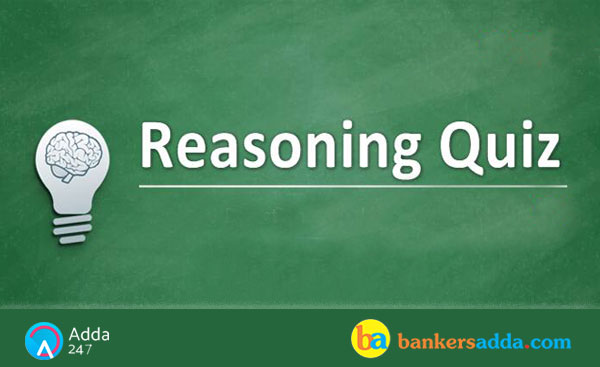Dear Aspirants,

Reasoning Questions for IBPS RRB 2018
Reasoning Ability is an onerous section. With the increasing complexity of questions, it becomes hard for one to give it the cold shoulder. The only way to make the grade in this particular section in the forthcoming banking exams like IBPS RRB is to practice continuously with all your heart and soul. And, to let you practice with the best of the latest pattern questions, here is the Adda247 Reasoning Quiz based on the study plan and the exact same pattern of questions that are being asked in the exams.
Directions (1-5): In this question, relationship between different elements is shown in the statements. The statements are followed by conclusions. Study the conclusions based on the given statement and select the appropriate answer.
Q1. Statements: P<Q<R=U, U≥T<S, T≥W
Conclusions:
I. U>W
II. U=W
(a) Only conclusion I is true
(b) Only conclusion II is true
(c) Either conclusion I or II is true
(d) Both conclusions I and II are true
(e) Neither conclusion I nor II is true
Conclusions:
I. H>F
II. A > J
(a) Only conclusion I is true
(b) Only conclusion II is true
(c) Either conclusion I or II is true
(d) Both conclusions I and II are true
(e) Neither conclusion I nor II is true
Q3. Statements: C = K < X < L > P ≤ R; Q ≥ C; P = M
Conclusions:
I. Q ≤ L
II. L > R
(a) Only conclusion I is true
(b) Only conclusion II is true
(c) Either conclusion I or II is true
(d) Both conclusions I and II are true
(e) Neither conclusion I nor II is true
(a) Only conclusion I is true
(b) Only conclusion II is true
(c) Either conclusion I or II is true
(d) Both conclusions I and II are true
(e) Neither conclusion I nor II is true
Conclusions:
I. Y< M
II. C < R
(a) Only conclusion I is true
(b) Only conclusion II is true
(c) Either conclusion I or II is true
(d) Both conclusions I and II are true
(e) Neither conclusion I nor II is true
Directions (6-10): In these questions, relationship between different elements is shown in the statements. These statements are followed by two conclusions.
Mark answer as
(a) If only conclusion I follows.
(b) If only conclusion II follows.
(c) If either conclusion I or II follows.
(d) If neither conclusion I nor II follows.
(e) If both conclusions I and II follow.
Q6. Statements: A>K>D>L, M≤C≤D, L>Q
Conclusions:
I. C < K
II. A > M
Q7. Statements: T ≥ M ≥ E, E<O, A>E>S
Conclusions:
I. T > O
II. S < O
Q8. Statements: G≥C>U, P=W≥U, W<N<T
Conclusions:
I. G > T
II. U < N
Q9. Statements: R>Q>J>D, M≤C≤J
Conclusions:
I. D > M
II. M ≥ D
Q10. Statements: Z≥V>U, R=E<U, E>M<O
Conclusions:
I. Z > E
II. U < O
Directions (11-15): In the following questions, the symbols @, $, *, # and & used with the following meaning as illustrated below:
‘P $ Q’ means ‘P is not smaller than Q’
‘P@Q’ means ‘P is neither smaller than nor equal to Q’
‘P # Q’ means ‘P is neither greater than nor equal to Q’
‘P&Q’ means “P is neither greater than nor smaller than Q’
‘P *Q’ means ‘P is not greater than Q’
Now, in each of the following questions assuming the given statements to be true, find which of the four conclusions I, II, III and IV is/are definitely true and give your answer accordingly.
Q11. Statements: T # U, L & M, U* P, M $ T
Conclusions:
I. M @ T
II. U @ P
III. T & P
IV. P @ T
(a) Only I is true
(b) Only III is true
(c) Only IV is true
(d) either III or IV is true
(e) either III or IV and I are true
Q12. Statements: U @ G, C * D, F # U, F * D
Conclusions:
I. F @ G
II. D @ U
III. C # U
IV. D @ G
(a) None is true
(b) Only I is true
(c) Only II is true
(d) Only III is true
(e) Only IV is true
Q13. Statements: S # N, Y $ H, P @ S, N & H
Conclusions:
I. N * Y
II. H @ S
III. P @ Y
IV. S # Y
(a) Only I, II and III are true
(b) Only I, II and IV are true
(c) Only II, III and IV are true
(d) Only I, III and IV are true
(e) All I, II, III and IV are true
Q14. Statements: X * U, W # V, S $ V, S @ U
Conclusions:
I. V # U
II. X # S
III. X # V
IV. S @ W
(a) Only II and III are true
(b) Only III and IV are true
(c) Only I, III and IV are true
(d) All I, II, III and IV are true
(e) Only II and IV are true.
Q15. Statements: H * L, H # F, M @ L, C $ F,
Conclusions:
I. F @ M
II. C $ L
III. M @ F
IV. C @ H
(a) Only I and II are true
(b) Only I is true
(c) Only III and IV are true
(d) Only III is true
(e) Only IV is true



 GA Capsule for SBI Clerk Mains 2025, Dow...
GA Capsule for SBI Clerk Mains 2025, Dow...
 The Hindu Review October 2022: Download ...
The Hindu Review October 2022: Download ...
 I Failed To Crack SBI PO, What Next?
I Failed To Crack SBI PO, What Next?





